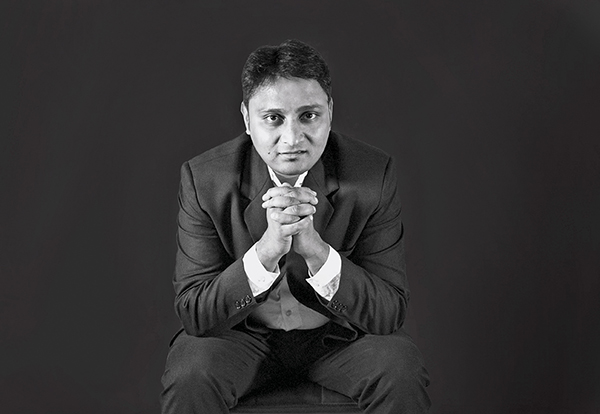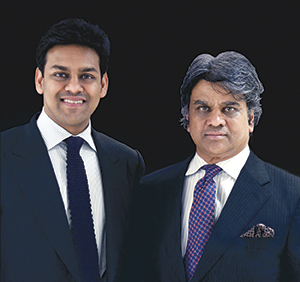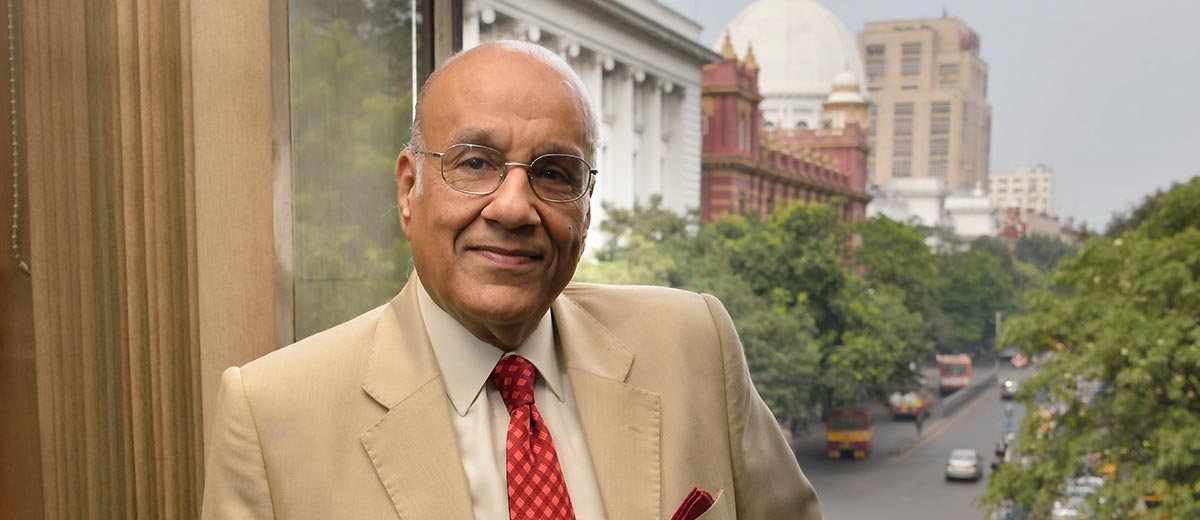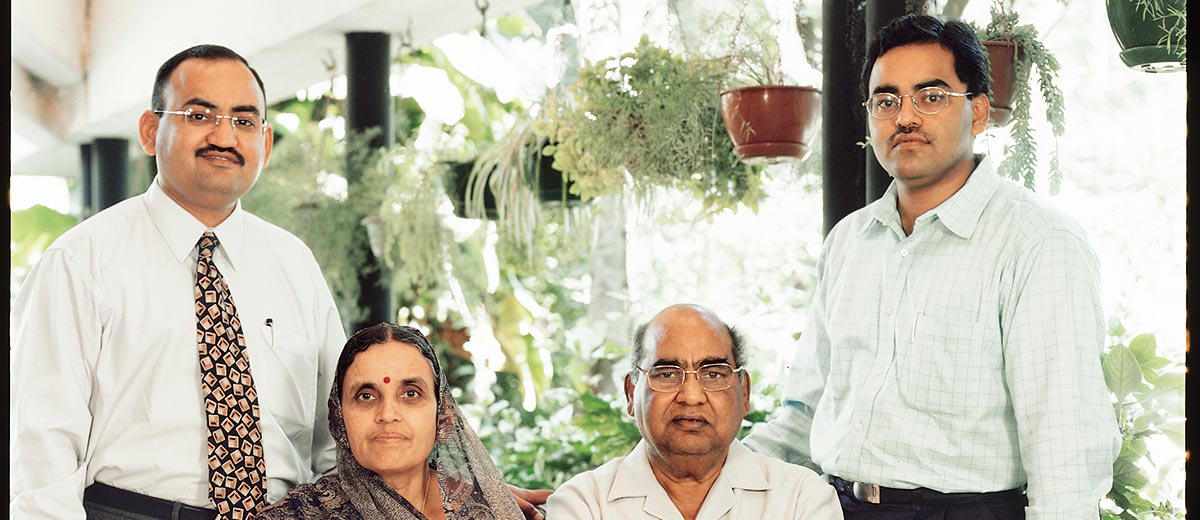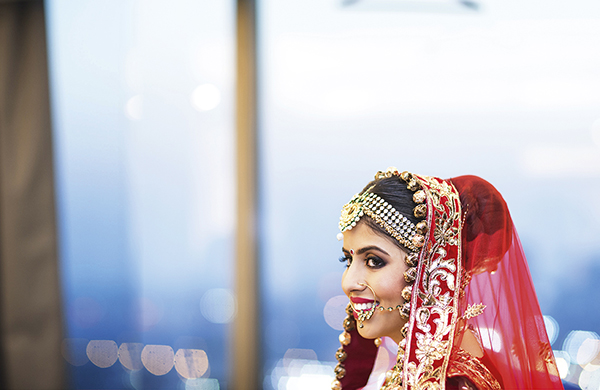
When Tradition Marries Opulence
When Tradition Marries Opulence
The extravagance, élan, and elaborate detailing of a Marwari wedding is like none other. It’s like transporting yourself to a fairy-tale land, or reading from the pages of royal history. Traditional rituals and customs are at the heart of a Marwari wedding, which surrounded by unbridled fun and festivity make for a grand spectacle indeed.
 Band, Baaja, Baaraat… just these three words can sum up the mood and gaiety around a wedding. And, of course, a Marwari wedding isn’t simply a wedding; it’s a mega event, to say the least. Months of planning, weeks of preparations, days of ceremonies—all come together for that one special moment when the couple commits to eternal togetherness.
Band, Baaja, Baaraat… just these three words can sum up the mood and gaiety around a wedding. And, of course, a Marwari wedding isn’t simply a wedding; it’s a mega event, to say the least. Months of planning, weeks of preparations, days of ceremonies—all come together for that one special moment when the couple commits to eternal togetherness.
Though the Marwari community takes pride in remaining rooted in traditions, there is often a modern twist to some wedding rituals. However, the crux largely remains unshaken. While some customs and rituals may or may not be a part of some Marwari families, here is how the Marwari wedding affair more or less flows:
Pre-wedding rituals
The celebrations begin with the Sagaai or Mudha-Tikka. This is held at the groom’s home, where the bride’s brother applies a kumkum-and-rice tikka on the groom’s forehead. This is a sign that the match has been accepted and sealed. Women are usually not present for this ceremony.
 Two days before the wedding, the bride’s and groom’s families initiate the wedding rituals by placing an idol of Lord Ganesha on a sacred pedestal, at the Ganpati Sthapana ritual. For the Griha Shanti, priests perform a puja or havan to appease the stars and planetary gods, so that they remain harmonious and bestow their blessings on the betrothed and their families during the ceremonies. Here, offerings are made to the fire, which is the core element of all the prayers. Both these rituals are performed at the bride and the groom’s respective homes.
Two days before the wedding, the bride’s and groom’s families initiate the wedding rituals by placing an idol of Lord Ganesha on a sacred pedestal, at the Ganpati Sthapana ritual. For the Griha Shanti, priests perform a puja or havan to appease the stars and planetary gods, so that they remain harmonious and bestow their blessings on the betrothed and their families during the ceremonies. Here, offerings are made to the fire, which is the core element of all the prayers. Both these rituals are performed at the bride and the groom’s respective homes.
More commonly known as Haldi, at the Pithi Dastoor ceremony, family members and close friends apply turmeric-sandalwood paste on the bride and groom at their respective homes. The bride adorns a traditional yellow or orange dress for this. The paste is generally applied on the face, hands and feet, and is known to bring about a beautiful natural glow to the face. Traditional wedding songs, beating of the dhol and good cheer characterise this ceremony. The same rituals are enjoyed at the groom’s home, too. After the Pithi Dastoor, neither the bride nor the groom is allowed to step out of the house, until the day of the wedding.
 As the very word suggests, Mehfils, also known as Sangeet, are joyous evening festivities held during the days before the wedding. Here, men and women get together with their respective groups and perform song and dance routines. The bride, the star of the evening, is brought in ceremoniously and made to sit on a special seat to enjoy the show.
As the very word suggests, Mehfils, also known as Sangeet, are joyous evening festivities held during the days before the wedding. Here, men and women get together with their respective groups and perform song and dance routines. The bride, the star of the evening, is brought in ceremoniously and made to sit on a special seat to enjoy the show.
The Mahira Dastoor sees the maternal uncle of both the bride and the groom visit their homes to present gifts and cash to all the family members and relatives. In return, the uncle is treated with delectable home-cooked food prepared specially for him by his sister (the respective mothers of the bride and groom).
Next comes the Palla Dastoor, where relatives of the groom gift the bride clothes, jewellery, cosmetics and accessories—in short, everything required for the main wedding day.
 At the Janev that follows (on the eve of the wedding), the groom performs a puja or havan, dressed in saffron clothes. After the havan, he wears a sacred thread called janev. Through this ceremony, he is made to understand and accept the many responsibilities of matrimonial life.
At the Janev that follows (on the eve of the wedding), the groom performs a puja or havan, dressed in saffron clothes. After the havan, he wears a sacred thread called janev. Through this ceremony, he is made to understand and accept the many responsibilities of matrimonial life.
Wedding day rituals
It’s time for the groom to get groomed! At the Nikasi, the groom’s brother-in-law (sister’s husband) ties a pagdi or headgear, followed by a sehra made of flowers or zari danglers, or at times even with strings of pearls, on his head. The groom’s bhabhi (brother’s wife) then applies kajal from her eyes to his eyes and ties golden threads on the ghodi or wedding mare. And then it’s finally time for the groom and his family to take the baaraat procession to the bride’s home or the wedding venue (as the case may be).
The Rajput Baaraat is literally a vision of regality straight out of the pages of royal history. The groom, along with his family and friends, heads to the wedding venue. Riding on a mare, he carries a sword in his hand, which signifies the majestic and military lineage of the region.
There’s beauty and décor from the very entrance itself at the bride’s house/the venue, with a beautiful toran adorning the entrance. The groom is supposed to hit it with a neem stick while entering the house. This is meant to keep negative energy at bay. Next the bride’s side greets and receives the groom at the entrance in the Baaraat Dhukav ceremony, which is followed by the bride’s mother performing an arti. She offers him sweets and water and welcomes him inside the venue.
 The bride is then brought into the wedding mandap ceremoniously. She puts seven suhalis—special snacks—on the groom’s head. And then comes the special moment, when the bride and the groom exchange garlands at the Varmala ceremony. The Granthi Bandhan ceremony follows where the bride and the groom’s odhnis are tied up in a knot, signifying the coming together of two souls forever.
The bride is then brought into the wedding mandap ceremoniously. She puts seven suhalis—special snacks—on the groom’s head. And then comes the special moment, when the bride and the groom exchange garlands at the Varmala ceremony. The Granthi Bandhan ceremony follows where the bride and the groom’s odhnis are tied up in a knot, signifying the coming together of two souls forever.
The bride’s father then gives her away to the groom during the Kanyadaan ceremony. The bride’s father asks the groom whether he would like to take responsibility of his daughter, and then the same ritual gets repeated with the bride accepting the groom’s family and his surname. The couple promises to be together through the highs and lows of life. Following the promises, the bride’s father places her hand on top of the groom’s, at the Panigrahan ceremony. The groom willingly accepts the bride’s hands from her father and then a sacred thread is tied over their joined hands.
The couple then takes seven Pheras around the sacred fire. The bride precedes the groom during the first three pheras, and then the groom takes the lead and she follows him in the last four. While taking the seven pheras, they recite the seven sacred vows of marriage that signify eternal union.
 The bride places her foot on a grinding stone and pushes it forward with her feet seven times, at the Ashwahrohan ritual. This stands for the challenges that she may face during her married life, all of which she shall fight with grit, determination and steadfastness. The bride’s brother then gives her a handful of puffed rice, which is offered into the sacred fire by the bride and groom at the Vamang Sthapan ceremony. She then sits to the groom’s left, indicating that she has been accepted into her husband’s family.
The bride places her foot on a grinding stone and pushes it forward with her feet seven times, at the Ashwahrohan ritual. This stands for the challenges that she may face during her married life, all of which she shall fight with grit, determination and steadfastness. The bride’s brother then gives her a handful of puffed rice, which is offered into the sacred fire by the bride and groom at the Vamang Sthapan ceremony. She then sits to the groom’s left, indicating that she has been accepted into her husband’s family.
After exiting the mandap, the newly-weds are ushered into a room in which a thapa (holy symbols of Kuldevi and Swastik) had been drawn in the morning. An elder female member from the bride’s family then makes them perform a puja of the thapa.
 The Mooh Dikhai follows where an elder female member of the groom’s family lifts the bride’s veil and sees her face and then the other family members come and bestow blessings and small tokens upon her. Then comes the Sir-guthi or Sindoor Daan, where a platter filled with rice, moong dal, jaggery, cash and sweets are given to the bride. The groom’s sister gently opens up the bride’s hair parting and the groom applies sindoor or vermillon there. The groom’s mother then brings a nath or nose ring and places it on the bride’s lap and she then wears it.
The Mooh Dikhai follows where an elder female member of the groom’s family lifts the bride’s veil and sees her face and then the other family members come and bestow blessings and small tokens upon her. Then comes the Sir-guthi or Sindoor Daan, where a platter filled with rice, moong dal, jaggery, cash and sweets are given to the bride. The groom’s sister gently opens up the bride’s hair parting and the groom applies sindoor or vermillon there. The groom’s mother then brings a nath or nose ring and places it on the bride’s lap and she then wears it.
The Saptapadi marks the beginning of their journey together as a couple. The bride’s father-in-law then drops a bag of money on her lap at the Aanjhala Bharaai ceremony, which is indicative of the groom’s family welcoming her into their home and heart. As a daughter-in- law, she must control the finances of her marital home in a wise and efficient way.
 Once the main wedding rituals are completed, a tikka is applied on the groom’s forehead and presents, including money, clothes and jewellery are gifted to him at the Paharavani ceremony. The bride then performs a puja at the threshold of her parental home and then breaks an earthen diya on it. Following this, the newly-weds are escorted out ceremoniously for the Bidaii where a tearful bride bids farewell to her parents’ home. This is an extremely emotional moment for the bride and her parents and family. A coconut is placed under the wheel of the car (to be crushed once the car starts) which will take them to the groom’s home. This is believed to bring good luck for the trip and marital life, in general.
Once the main wedding rituals are completed, a tikka is applied on the groom’s forehead and presents, including money, clothes and jewellery are gifted to him at the Paharavani ceremony. The bride then performs a puja at the threshold of her parental home and then breaks an earthen diya on it. Following this, the newly-weds are escorted out ceremoniously for the Bidaii where a tearful bride bids farewell to her parents’ home. This is an extremely emotional moment for the bride and her parents and family. A coconut is placed under the wheel of the car (to be crushed once the car starts) which will take them to the groom’s home. This is believed to bring good luck for the trip and marital life, in general.
Post-wedding rituals
Griha Pravesh: Once the couple arrives at the groom’s home, his mother performs an arti before welcoming the bride to her new home. The bride steps in, placing her right foot over the threshold into a tray filled with a milk-and-vermillon mixture. With her feet coloured in red, she takes five steps inside and kicks over a pot containing rice and a coin, which symbolise fertility and wealth, respectively.
 At the Pagelagni ritual that follows, the bride is formally introduced to the groom’s family members and is showered with blessings and gifts. A puja is performed to honour her. The bride’s mother-in-law then presents her with chooda, a set of red and white-coloured bangles made of lac and ivory. This is a gesture of acceptance into her new home.
At the Pagelagni ritual that follows, the bride is formally introduced to the groom’s family members and is showered with blessings and gifts. A puja is performed to honour her. The bride’s mother-in-law then presents her with chooda, a set of red and white-coloured bangles made of lac and ivory. This is a gesture of acceptance into her new home.
Reliving Beautiful Memories
Prerna Nigotiya and Pulkit Jain tied the knot on November 23, 2017. Reminiscing about the fairy-tale affair, Prerna Nigotiya says:
“Having a perfect, fairy-tale wedding was our dream, and it came true! Since our families wanted a heritage wedding, we zeroed in on Jaipur. From November 21 onwards our family members and friends started pouring in from around the world. The D-Day was November 23. The highlight of the evening was the bridal entry where I entered on a Cinderella cart and reached the varmala stage. The grand pavilion had just Pulkit and me on it. As we exchanged the varmala, fireworks and mesmerising music rent the air. We felt like a king and queen at that particular moment. It was the most special moment for both of us and will be cherished in our hearts forever.”
Sneha Rateria and Aditya Agarwal got married on December 3, 2017. Remembering her special day, Sneha says:
It was the day on which Aditya and my life would  change forever. Our families took care of everything and made the day seem like a big fun-filled party. Never before had The Taj Bengal, Kolkata looked so pretty!
change forever. Our families took care of everything and made the day seem like a big fun-filled party. Never before had The Taj Bengal, Kolkata looked so pretty!
The rose-laden mandap was the highlight of it all. All the events were very elegant and intimate and my family made sure that the wedding was way above my expectations—the rose-covered hallways, candlelit banquets, delicious food and rocking performances by various artistes. We did not even realise how time passed by that weekend because we were having so much fun. The best part about Marwari weddings are the rituals. All the customs are so enjoyable. My most favourite ritual was Sir-guthi, where I was pampered by all my sisters-in-law—they did everything possible to make me feel special! I was worried that I would be a ball of nerves, but instead, I was a super-relaxed bride.
I didn’t behave like a typical bride and rather enjoyed every bit of it. I made the most of my Big Day!”
Amrita and Rishi Jalan got married on July 8, 2010. Recalling some of those special moments, Amrita says:
 “My favourite rituals were thape ki puja and mooh dikhai. These rituals are done right after coming out of the mandap. We (as bride and groom) were led into a room in which the thapa had been drawn. My mom made us perform a puja of the thapa first and then asked my husband to recite some shlokas (beautiful verses that described his love for me).
“My favourite rituals were thape ki puja and mooh dikhai. These rituals are done right after coming out of the mandap. We (as bride and groom) were led into a room in which the thapa had been drawn. My mom made us perform a puja of the thapa first and then asked my husband to recite some shlokas (beautiful verses that described his love for me).
She lifted the veil from my face and allowed him to see my face only after she was satisfied with the shlokas. It was absolutely hilarious as my mom literally grilled Rishi for better shlokas. Thereafter, the entire bride’s side showered us with token gifts. This particular ritual really lifted our moods.”


